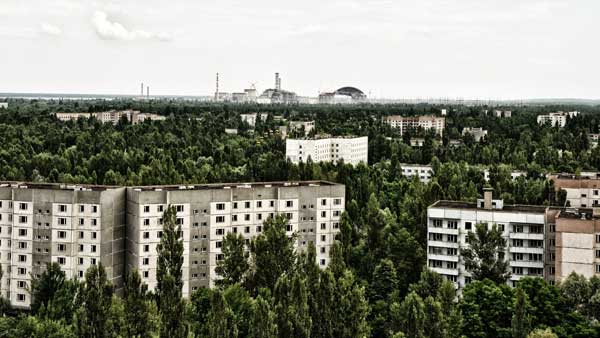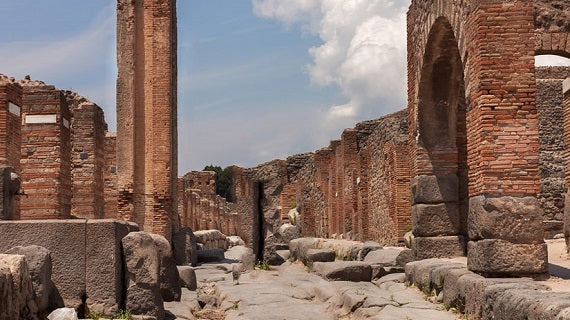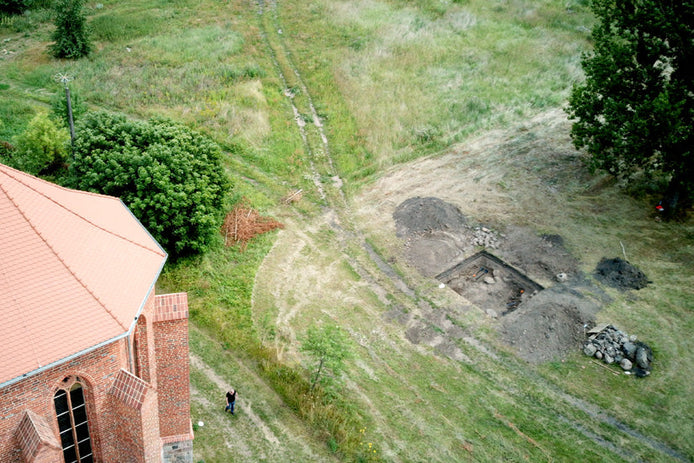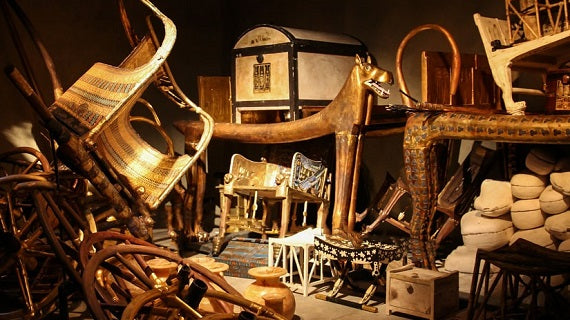Lost Places
"Downtown" from a Different Perspective: Lost Places Below the Earth tell their Stories
In order to create new living space and constantly improve the urban infrastructure, supply lines, underground tunnels and car parks are being built. It is not unusual for construction companies to come across old walls and vaults, which are of great interest to archaeologists, especially in city centers. With appropriate detection technology such as ground scanners and cavity detectors, these old tunnels, vaults, wells, cisterns and aqueducts can be discovered and located before civil engineering work begins.
The rediscovered cities of past centuries were covered or replaced in the course of time – some vaults continued to be used and remained intact, others have been forgotten at some point. Often the foundation walls, remains of buildings and galleries are well-preserved and protect artifacts and treasures which wait to be rediscovered.

Tschernobyl (Ukraine)
Tschernobyl steht für die größte Katastrophe in der Geschichte der Kernenergie-Nutzung: In dem ukrainischen Atomkraftwerk kam es am 26. April 1986 zur Kernschmelze. Der Reaktor Block 4 explodierte und radioaktiver Staub verbreitete sich in ganz Europa. Die Region ist bis heute unbewohnbar, Mensch und Natur kämpfen mit den Spätfolgen.Insgesamt wurden 150.000 km² in Weißrussland, der Ukraine und Russland durch den Reaktorunfall in Tschernobyl radioaktiv verseucht. Ein Gebiet, in dem damals fünf Millionen Menschen lebten. Mehr als 330.000 Menschen, die in unmittelbarer Nähe des Reaktors gelebt hatten, mussten evakuiert werden.

Eastern State Penitentiary (USA)
Das Eastern State Penitentiary ist eine ehemalige Strafanstalt in Philadelphia, im US-Bundesstaat Pennsylvania, die von 1829 bis 1971 als solche genutzt wurde und seit 1994 als Museum dient. Bereits 1787 stellte eine Gruppe bekannter Bürger Philadelphias, darunter Benjamin Franklin, erste Überlegungen zum Bau des Gefängnisses an. Konkrete Planungen begannen aber erst 1821. Realisiert wurde der Bau vom englischen Architekten John Haviland von 1822 bis 1829. Am 23. Oktober 1829 nahm die Strafanstalt ihren Betrieb auf. Um schon von weitem eine abschreckende Wirkung zu erzielen, ist das Gebäude äußerlich einer mittelalterlichen Burg nachempfunden.

Oradour-sur-Glane (Frankreich)
Oradour-sur-Glane (okzitanisch Orador de Glana) ist eine französische Gemeinde mit 2478 Einwohnern (Stand 1. Januar 2020) im Département Haute-Vienne in der Region Nouvelle-Aquitaine. Sie liegt 200 Kilometer nordöstlich von Bordeaux und 22 Kilometer nordwestlich von Limoges. Der Ortsname leitet sich vom lateinischen oratorium „Gebetsstätte“ ab. Bekannt wurde der Ort vor allem durch ein während des Zweiten Weltkrieges nach Partisanenangriffen am 10. Juni 1944 von der SS-Panzerdivision „Das Reich“ verübtes Kriegsverbrechen, bei dem der Ort vollständig zerstört und fast alle seine Einwohner ermordet wurden. Nach dem Krieg wurde neben dem zerstörten alten ein neuer Ort aufgebaut. Den Überresten des alten Dorfes ist heute eine Mahn- und Gedenkstätte mit einem Dokumentationszentrum angeschlossen

Wonders of Antiquity: Underground Rome (Italy)
Many stairs lead deep below the Italian capital into underground corridors, tunnels and churches, which have been under the metropolis for 2500 years.

Secret passages: The catacombs of Paris (France)
Since the Middle Ages, limestone has been mined in the mysterious corridors. The galleries are several kilometers long and lie far below the sewerage system. At the end of the tunnels there are bones of six million people.
Not only the catacombs of Paris and Rome are underground “cities” of a special kind. In Jerusalem, the ancient tradition is being revived: Even today, new underground Jewish cemeteries are still built.

Complex connection between the Hasmonaean age and modernity: The tunnels under Jerusalem (Israel)
Under the impressive Wailing Wall there are tunnels leading along for about 448 meters. The complex underground tunnels were first discovered by British archaeologists in the 19th century. The actual excavations were carried out 100 years later by the Ministry of Religions.

Bunkers of the Second World War: The Underworld of Berlin (Germany)
Under the world-famous Berlin, there is also an underground city: the “Underworld” houses an impressive protection bunker from the Second World War. The numerous corridors and rooms of the bunker complex resemble a labyrinth. Moreover, the Berlin sewage system is one of the oldest, best and largest in Europe.
Teufelsberg (Deutschland)
Der Teufelsberg ist ein Trümmerberg im Westen Berlins und nach Messungen aus dem Jahr 2013 mit 120,1 nach den Arkenbergen die zweithöchste Erhebung des Stadtgebiets. Der Hügel – mit Aussicht über das Naturschutzgebiet Grunewald und die Havel – liegt im Ortsteil Grunewald (Bezirk Charlottenburg-Wilmersdorf) an der Teufelsberg Seechaussee zwischen den S-Bahnhöfen Grunewald und Heerstraße. Er hat seinen Namen vom nahe gelegenen Teufelssee. Auf dem Berg befinden sich die markanten Bauten einer Flugüberwachungs- und Abhörstation der US-amerikanischen Streitkräfte. Nach dem Abzug der Militärs wurde die Anlage von 1991 bis 1999 als Flugsicherungsradar-Station genutzt. Seitdem stehen die Gebäude leer und verfallen.


Deep well: The underground labyrinth of Derinkuyu (Turkey)
In the Turkish region of Cappadocia, there are underground cities, some of which date back to the 8th century BC. Derinkuyu is the largest and was probably built by the Hittites. The multi-storey labyrinth of ventilation shafts, wells and a wine cellar served 20,000 people as living space and refuge.

Roman and Greek Roots: Historical Roads under Naples (Italy)
About 40 m below ground there is an old city under the “new” city of Naples, which reminds of its Greek and Roman roots. The underground structures reveal paved streets, remains of an aqueduct, shopfronts and a Roman theater.

The legendary underworld: South Bridge Vaults in Edinburgh (Scotland)
Not as ancient as the Roman walls or as old as the Paris catacombs, but still exciting and fascinating: the confusing passages under the South Bridge in Edinburgh. The chambers in the arches of the bridge were used in the 18th century as warehouses, workspaces and living quarters, but were closed in the middle of the 19th century and were forgotten. It was not before 1989 when the chambers filled with historical artifacts have been rediscovered.
Lost place at the foot of the volcano: Plymouth (Caribbean)
Unlike the previous cities, Plymouth, capital of the British overseas territory of Montserrat (Lesser Antilles), was afflicted by a force of nature: The volcano Soufrière Hills erupted several times between 1995 and 1997 and buried the buildings under 1.5 m ash masses.

The warship phantom island: Hashima (Japan)
160 m wide and 480 m long, this awesome concrete island rises out of the East China Sea. From the end of the 19th century to the middle of the 20th century, coal mining attracted tens of thousands of workers to the city, which is surrounded by high protective walls to protect it from waves. Today, Hashima is an industrial monument.


